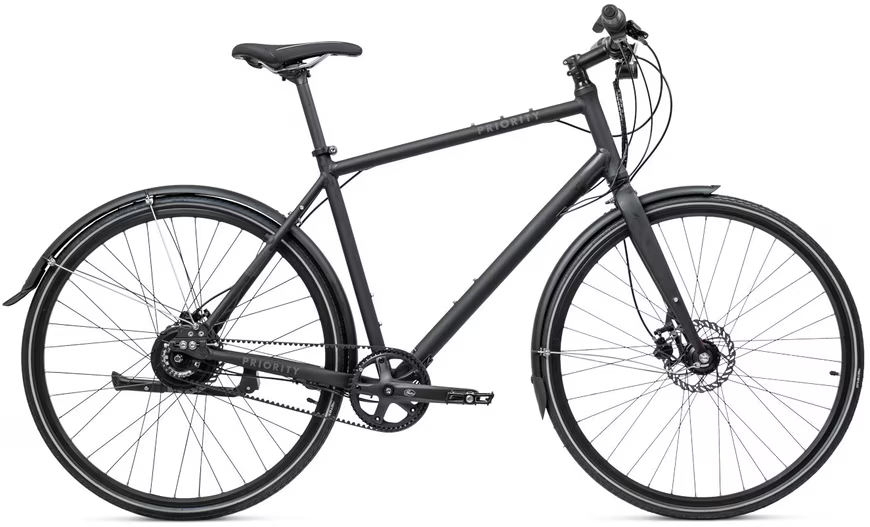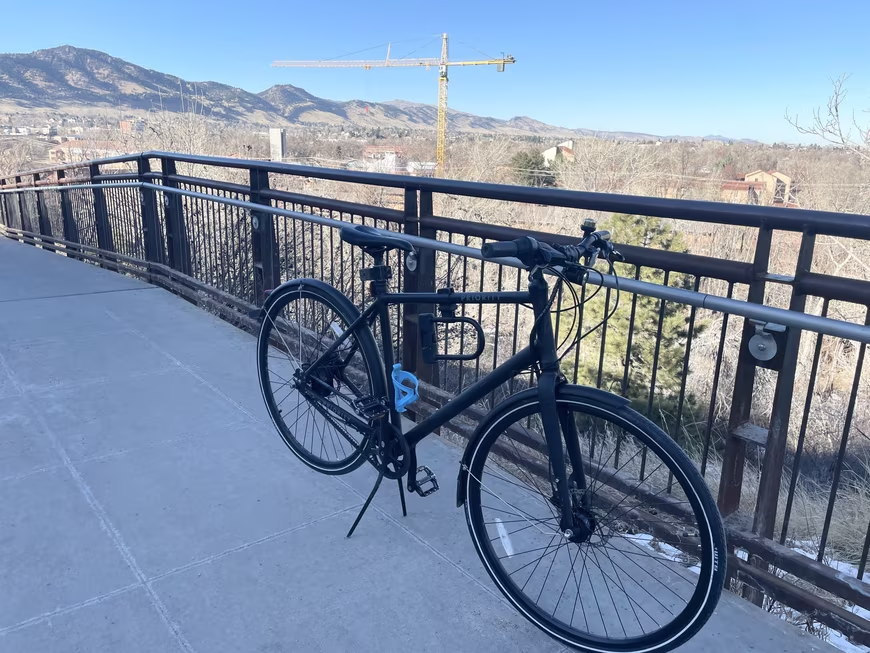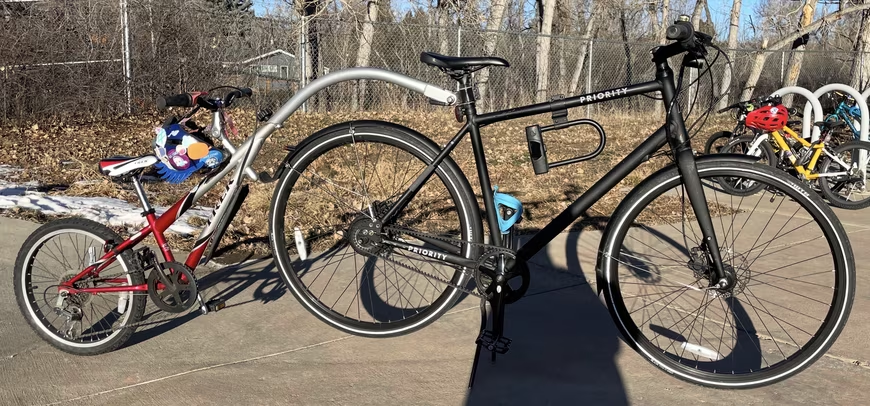I realized that I've written here about my Santa Cruz MTB and my Orbea Road Bike, but that I never wrote about my commuter bike because I purchased it during the period when I stopped writing to this blog. Today I'll fix that omission!
In late summer 2020 I purchased a Priority Continuum Onyx to replace my Frankencommuter bike. My old commuter was a hodgepodge of parts: a Nashbar road bike frame (called the "Framé" and no longer available for purchase), along with various used bike parts I acquired over the years; mostly from when I upgraded parts on my bikes. It was fine for what it was but after using it for about ten years it was wearing out and I was ready for something nicer. There were aspects of the bike that could never be fixed. In particular, the inability to fit fenders to the frame led me to decide something else was needed.
After doing research I decided I wanted a belt drive bicycle. I was interested in belt drive bikes because all the positives (listed here) seem perfect for a commuter and the negatives unimportant, or at least less important than the positives. They are low-maintenance, long-lasting, and clean. There are negatives (listed here; more later), but even some of the negatives have positives. For example, it's impossible to shift gears on a belt drive using a standard derailleur. To have more than one gear requires an internal gearing system, often placed in the rear wheel hub. This makes the bike more complicated, heavier, and less efficient. However, because the gearing is internal, it's sealed away from rain and dirt and requires less maintenance, exactly what I want from a commuter bike.
Priority bicycles sells only belt drive models, and I settled on the Continuum Onyx. It had basically everything I wanted:
- Belt drive
- Continuously variable transmission (CVT) internal rear hub (more on this later)
- Fenders
- Built-in lights using a front-hub dynamo
- Hydraulic disc brakes
- Reflectors everywhere, including the tire sidewalls
- Upright seating with flat bars
- Forgiving 32C tires
- "Acoustic" a.k.a. non-electric. At home I have to carry my bikes up and down a flight of stairs and I didn't want a bike that weighed 50-60 pounds
About the only thing they omitted, and probably should include on a city commuter bike, is a bell. Like reflectors, bells are legally required in many jurisdictions (but never enforced, really). I have added a bell and it's useful.
The are definitely negatives to a belt-driven bicycle. The bike is fairly heavy, especially in the back (although I'm probably spoiled by my other quite light bikes). It's also clearly less efficient than a standard chain-driven bicycle. I am not as fast as I think I would be on a similar non-belt driven bicycle at a given level of effort. Many parts of the bike would be hard to fix on the go. However I only ride it in town, and worst case I'll leave it locked up somewhere and use my bus pass to get where I'm going and return for it later. Doing any kind of maintenance that requires removing the rear wheel is a decent hassle.
The CVT rear hub has its plusses and minuses. On the positive side, in contrast to a traditional derailleur, it doesn't require any fine adjustment. It uses a single grip shifter(*), meaning that the bike can reasonably be operated with one hand that can both shift and brake (e.g. you're carrying a pie in your other hand). Coming from typical bikes with set gear ratios the CVT is at first very weird, but being able to change the ratio by just a smidge is useful. The minuses come down to the same issues mentioned above: weight, efficiency, and difficulty of working with the rear wheel. In my opinion the plusses outweigh the minuses.
After four and half years of ownership, it has indeed been a very low-maintenance bicycle. Other than pumping up the tires once or twice a month:
- I recently replaced the brake pads (front and back) and bled the hydraulic brakes. I've done this before on my mountain bike, and once I figured out how to shimmy the bleed block into the brakes, it was actually easier than the Santa Cruz
- I can't remember the last flat tire, and I think I've had less than 5 flats overall
- The new (see below) kickstand spring mechanism gets gummed up with road grime and about twice a year needs to be cleaned out
I do have some minor to medium complaints about the bike that mostly consist of the items Priority saved a few bucks on:
- The factory-spec kickstand was flimsy and I had to replace it when it broke. I replaced it with a two leg kickstand (holy moley, how can someone write hundreds of words about a kickstand?) that is far stronger and better than the original one. The one I purchased is especially nice and I spent more than I could have, but the one Priority supplied was not very well made
- I'm on the third bottom bracket. For both previous the bearings holding the spindle went bad and the bottom bracket developed a very annoying click. It is likely that a higher quality bottom bracket would solve this issue
- The connector that links the dynamo hub to the wire that runs to the lights is cheap and needlessly difficult to reattach after removing the front wheel. It's probable that this connector is matched to the hub, and the dynamo hub is not manufactured by Priority, but it's annoying
- The provided pedals were plastic which I replaced with some metal ones I already had. Looking at flat pedals online, the cheapest metal pedals are only a few bucks more than the least expensive plastic ones. Surely this price difference is smaller when buying in bulk
- I have replaced the saddle. Saddles are a very personal choice and it's impossible for one saddle to work for everyone. No fault to Priority here
Overall I have been and am very satisfied with the bike. It has delivered on almost all of the promises of a belt-driven bicycle. If Priority & the dynamo manufacturer made the choice to spend a few more bucks (and really, just a few bucks!) in a few places, my complaints would be basically zero.
(*) I generally dislike grip shifters, but considering how the CVT works, I think this is an exception, and it's a good solution.


